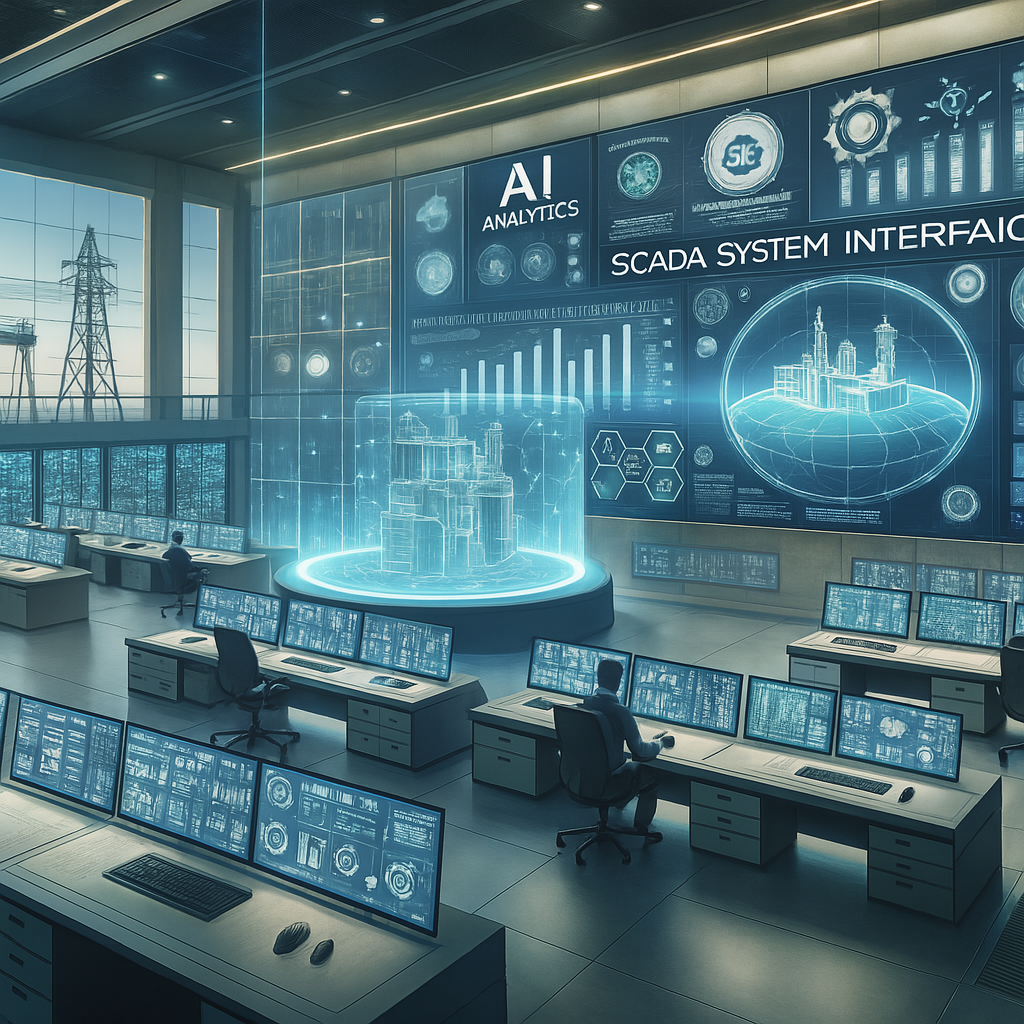SCADA Technology: Future Trends
As industrial automation advances, SCADA (Supervisory Control and Data Acquisition) systems are rapidly evolving. The integration of Industry 4.0, cloud computing, AI, and IoT is transforming SCADA into a smarter, more predictive, and highly efficient system. This post explores the emerging trends that will shape the future of SCADA technology.

1. Industry 4.0 and Smart SCADA Systems
SCADA is playing a key role in Industry 4.0, where industrial automation is transitioning towards intelligent, interconnected, and autonomous operations.
Key Advancements
- Digital Twin Technology: SCADA is integrating digital twin models, allowing real-time simulation of industrial processes before implementing physical changes. Reduces downtime and improves predictive maintenance.
- Cyber-Physical Systems (CPS): SCADA is merging with AI-driven automation, enabling real-time self-optimizing systems. Machines can automate adjustments without human intervention.
- Edge Computing for Faster Decisions: SCADA will process data at the edge, reducing reliance on centralized servers. Enables faster decision-making and reduced latency in industrial automation.
Example: Smart Manufacturing – SCADA with CPS is enabling self-regulating production lines, reducing material waste by 18%.
2. Cloud-Based SCADA and Remote Access
Cloud technology is revolutionizing SCADA by offering scalability, cost reduction, and remote accessibility.
Key Advancements
- SCADA-as-a-Service (SCADAaaS): SCADA systems are moving to the cloud, offering on-demand services with no need for expensive on-premise infrastructure.
- Real-Time Remote Monitoring: Operators can access SCADA dashboards from mobile devices or web applications, improving flexibility and responsiveness.
- Automated Backups and Disaster Recovery: Cloud-based SCADA provides secure data storage and instant recovery, preventing data loss due to cyberattacks or system failures.
Example: Smart Energy Grids – Cloud-based SCADA in power distribution networks reduced outages by 30% through real-time demand monitoring.
3. AI and Machine Learning in SCADA
Artificial Intelligence (AI) and Machine Learning (ML) are making SCADA smarter by enabling predictive analytics and automated decision-making.
Key Advancements
- Predictive Maintenance: AI-powered SCADA predicts equipment failures before they occur, preventing unexpected downtimes and extending machine lifespan.
- Anomaly Detection & Automated Responses: SCADA uses AI to detect irregularities (e.g., unusual temperature spikes) and automatically adjusts machine settings to prevent damage.
- Self-Learning Systems: ML algorithms analyze historical data to continuously improve operations, optimizing energy consumption and production efficiency.
Example: Oil & Gas Pipeline Monitoring – AI-enabled SCADA prevented pipeline leaks, reducing maintenance costs by 20%.
4. IoT-Enabled SCADA for Smart Industries
The Internet of Things (IoT) is reshaping SCADA, making it more connected, intelligent, and scalable.
Key Advancements
- IoT Sensors for Smart Monitoring: SCADA systems now integrate with low-power IoT sensors that continuously monitor air quality, machine vibrations, fluid flow, etc.
- MQTT-Based Communication for Low Bandwidth: Lightweight IoT protocols (e.g., MQTT) improve SCADA’s data transmission efficiency, suitable for remote industries like agriculture, offshore oil rigs, and mining.
- IoT-Enabled Remote Control: Operators can control SCADA from any location using IoT-connected devices. Useful for wind farms, remote factories, and smart water treatment plants.
Example: Smart Agriculture – IoT-based SCADA reduced water usage by 40% by monitoring soil moisture in real time.
5. Enhanced Cybersecurity for SCADA Systems
With SCADA becoming more connected, cybersecurity is a major concern. Advanced security measures are essential to protect industrial control systems.
Key Advancements
- Zero-Trust Security Models: Strict access control policies ensure that only authorized personnel can modify SCADA systems. Multi-factor authentication (MFA) prevents unauthorized access.
- Blockchain for Data Integrity: Blockchain ensures tamper-proof SCADA logs, preventing cyberattacks and providing secure transaction records for utilities and smart grids.
- AI-Powered Threat Detection: AI monitors SCADA networks for cyber threats in real time and automatically isolates infected systems to prevent damage.
Example: Smart Grid Cybersecurity – AI-enhanced SCADA reduced cybersecurity breaches by 50% in critical power infrastructure.
6. SCADA for Green Energy and Sustainability 🌱
As industries shift towards sustainable operations, SCADA is evolving to support renewable energy and environmental monitoring.
Key Advancements
- SCADA in Smart Grids: Helps manage renewable energy sources (solar, wind, hydro) and balances grid load fluctuations for stable energy distribution.
- Carbon Emission Monitoring: Tracks and optimizes factory emissions, energy usage, and waste generation, ensuring compliance with environmental regulations.
- Water and Waste Management: SCADA in wastewater treatment plants helps recycle and reuse water efficiently.
Example: Smart Renewable Energy Plant – SCADA optimized wind farm energy output by 25%, reducing dependence on fossil fuels.
Future-Proofing SCADA: What’s Next?
As SCADA evolves, industries must prepare for upcoming trends:
| Future Trend | Expected Impact |
|---|---|
| Quantum Computing | Faster data processing for ultra-complex SCADA calculations. |
| 5G Integration | Low-latency communication for real-time control of industrial systems. |
| Augmented Reality (AR) HMIs | Operators can visualize SCADA systems through smart glasses for maintenance. |
| Self-Healing SCADA Networks | AI-driven SCADA will automatically repair system failures. |
SCADA is no longer just about monitoring and control—it is becoming smarter, more secure, and highly automated. By embracing AI, cloud computing, IoT, and cybersecurity advancements, SCADA will transform industries, making them more efficient, sustainable, and resilient.
